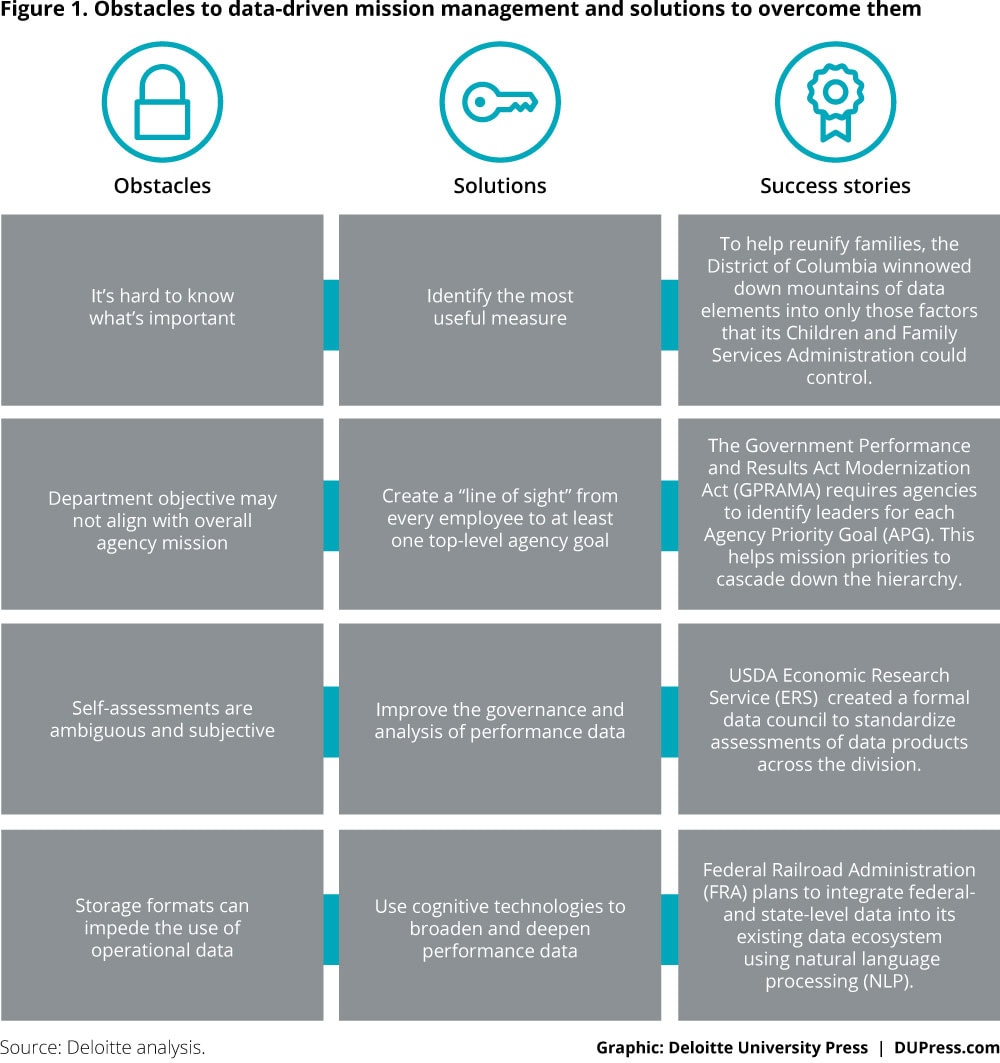Executive summary: Mission analytics has been saved

Executive summary: Mission analytics Data-driven decision making in government
26 September 2016
 Mahesh Kelkar India
Mahesh Kelkar India Peter Viechnicki United States
Peter Viechnicki United States Sean Conlin United States
Sean Conlin United States Rachel Frey United States
Rachel Frey United States
Big data and evidence-based decision making are transforming the world, from health care to retail sales—and increasingly transforming the public sector as well. But unlike for-profit companies, government agencies face unique challenges in defining and measuring success.
Government has reached a tipping point for data-driven decisions
Big data and evidence-based decision making are transforming the world, from health care to retail sales—and increasingly transforming the public sector as well. Data analytics can allow governments to allocate their resources for maximum effect. But unlike for-profit companies, government agencies face unique challenges in defining and measuring success.
In fact, despite numerous efforts, successful data-driven resource allocation has been quite rare in government—until recently. Since around 2010, two factors have rendered data-driven mission management much more achievable: dramatic advances in information technology, and the rise of data science, visualization, and analytics.
These developments have made it easier for government officials to access and understand the statistics that illuminate mission success—to make sense of operational data and turn them into usable insights for the critical mission of resource allocation.
We examine some cases in which new data tools are achieving results through what we call the “mission analytics framework,” and offer some guidelines for avoiding common data and measurement pitfalls.
Use smarter analytics to save time, money and energy
Governments manage three main categories of resources: people, physical assets, and money.
People
Human capital is generally the biggest and most critical resource that an agency has to manage, often exceeding a third of the total budget.1 Data analytics can help agencies decide how to deploy staff for maximum effectiveness. For instance, Pennsylvania’s Bureau of Child Support Enforcement uses a “payment score calculator” to advise caseworker outreach to noncustodial parents.
Equipment and physical assets
The second major category of resources includes physical assets, from weapons systems to field offices. Modern analytic tools support more objective decisions for allocating these assets. For example, the United States Immigration and Customs Enforcement (ICE) uses a data-driven approach to choose new international office locations.
Money
The third critical resource government employs to achieve its mission is funding, such as grants, loans, and guarantees. For the federal government, grant funding is a $600 billion question: How should government agencies decide which organizations should receive a grant? One agency using data to manage money is the United States Federal Railroad Administration (FRA), whose enterprise data store helps forecast the effect of its investments on outcomes.
The four stages to becoming a data-centric organization
Many government agencies want to use data to improve their resource decisions, but may lack a clear roadmap for doing so. Our research shows that most agencies that transform themselves into data-centric organizations go through four stages. We call this the mission analytics journey.
Step 1: Make your mission measurable
The first step is to define the mission in ways that make it quantifiable. The premise is that specific and challenging goals, combined with continual analysis and feedback, can improve performance.2 For instance, the United States Department of Agriculture’s Economic Research Service (ERS) broke its mission into quantifiable outcomes, allowing it to align resources to mission-critical elements.
Step 2: Collect mission-critical data
Defining and refining mission-critical measures is only the first step on the mission analytics journey. The enterprise then must create a platform that allows for the collection, storage, and dissemination of all relevant data. Different datasets may have to be brought together to gain a full picture of mission performance.3 The FRA, for example, built an enterprise data store by tapping into internal and external data sources.
Step 3: Use analytics to move from data to insights
The third step in the journey is to build tools to pull meaning out of the data compiled and measured during the first two steps. Performance information has little significance in itself. It should be translated into meaning to become valuable. To do this, Washington, DC’s Child and Family Services Agency built a statistical model to identify children most at risk.
Step 4: Translate insights into organizational action
Insights without actions are of little value. Agencies that successfully use data analytics to improve their operations rely on feedback mechanisms to translate insights into concrete operational changes.4 Virginia’s Department of Social Services’ “managing by numbers” approach, which helps to reduce pending benefit applications in the state, offers an example.
Overcoming the obstacles to data-driven mission management
While these success stories are inspiring, the journey to data-driven mission management is not without challenges. These challenges span across the cultural and systemic aspects of government. Our research has uncovered four solutions that can help government agencies overcome common obstacles to data-driven mission management.
Today’s “extraordinary” will become routine
The journey toward data-driven resource allocation requires political leadership, a commitment to sustained technological progress, and a willingness to measure and report on success transparently. Done right, it can dramatically boost performance.
Mission-driven analytics have the potential to allow government agencies to do more with limited resources. The technology has advanced to the point at which data can be captured, collected, and analyzed efficiently. Linking data to an organization’s mission may soon become commonplace. More and more public leaders, like those described in the full report, will work to create a data-driven culture that promotes agency missions and the fulfillment of public purpose.





